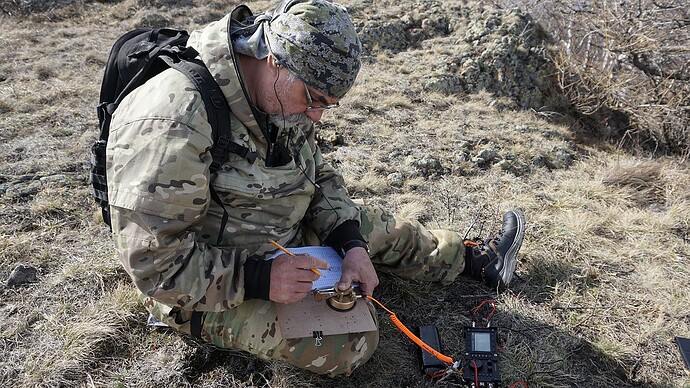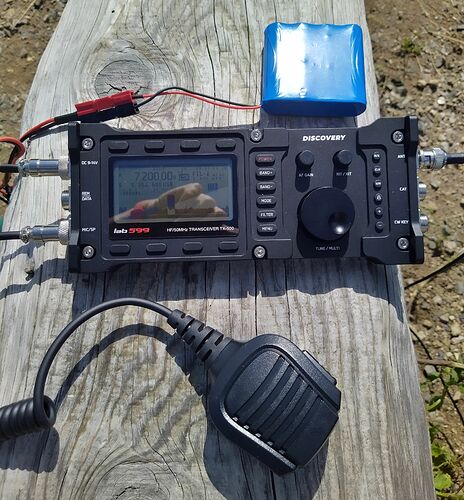Unboxing videos are a thing to show you what you get. You’re welcome to ask why they don’t just show a picture of the contents. More difficult to get advertising clicks most likely.
Designed to generate anticipation and desire. Helps you picture the moment when you unbox yours. All part of marketing and advertising campaigns… 
I’ve never had so many bites as when I tried using Skin So Soft. It literally felt like an attractant.
I can’t stand Deet either. It’s greasy and can damage plastic. I use permethrin on my clothing and picaridin on my skin.
Chris
Hi!
R8WB recently bought this transceiver. Since we went to the activation together, I had the opportunity to watch and listen to this radio.
I can say that among all portable transceivers, the TX-500 stands out for the quality of its receiver. It’s just nice to listen to. I am not often satisfied with DSP in modern radios. After listening to the TX-500 in CW, with different filter and AGC settings, I was completely satisfied for the first time. I have no doubt that the form factor of this transceiver is great for travel enthusiasts. And not only SOTA. The aluminum chassis and water resistance add to the cost of this radio, but I think it makes perfect sense for a really travel radio!
There are moments with this transceiver in the video. And you can hear pretty good work in CW.
73!
Vlad
RX9WT
Never mind the radio, that’s a nice looking paddle and even better, a fine looking DPM bandana 
R8WB, Serge made this paddle himself. He has a video about it on his YouTube channel. I am not a fan of camouflage, perhaps this is due to my previous service in the army. But the bandana looks quite convincing ))
73
In fact, that is all I can see. Is there actually a person in the picture?
The radio, while impressive, is not waterproof.
When I first saw this radio I instantly wanted one. Then, after learning about relay switching and those irritating clicks I became less enthusiastic (I sold a 7300 for that reason). Can anybody tell me how those clicks sound when you are actually out in the world on a summit?
The clicks, apparently, were so weak that I did not pay attention to them. And on the table, in the shack too.
73
Vlad
Clicks are not heard, because small-sized high-quality relays are used.
As for this radio. This is a very great radio! I am completely satisfied with it and do not regret a single cent spent! Excellent individual design, compact, only 500 grams, an excellent receiver, an excellently designed user interface, an all-aluminum durable case, dust and moisture protection, a high-contrast monochrome display (I can’t understand why a color display is needed in the mountains? It only complicates the perception of information). Summary: excellent radio, worthy of the money spent!
Hi Andrey! We conducted a QSO with you 2may2021 12:28 20M CW. I was working on a TX500 to a simple dipole raised on trees. Without PA, only 10W. This is more than 15,000 km. And I copy you perfectly.: -)
Hi Sergey,
I agree with you, even I couldn’t try this rig myself until now, so all I say here is pure theory and speculation.
Most of the feedback I read from other users is excellent so far. With one exception, all users find it fits perfectly in this narrow niche of running this rig under harsh environment conditions.
The low RX current drain (even less than the KX2), the optimal heat dissipation, the way the robust connectors are connected with the PCB (not directly soldered to the PCB) are signs of well thought out design.
Also the magnetically attached battery case that is in development, holding six replaceable 18650 cells (I guess 3S2P) is just a great idea. I.e. one can source the readily available li-ion batteries locally. Moreover, it seems that one can charge it directly from a solar panel (I think up to 30V or so and of course while running it), so no external step-down converter is necessary. Time will tell.
OK, I know that owners are usually biased and less critical than they should be, this is typical human behavior. Once I could play with this rig myself, I’ll try to give an objective and critical feedback, containing all it’s pros and cons.
73 Stephan
Hi Stephan! Thank you for your replay! I am always very wary and critical even of my own acquisitions. And I honestly tried to find serious flaws in the TX-500. But I did not find them for 3 months of ownership. Of course, there is something to improve, because there is no perfect equipment. But in general, the transceiver is very worthy and in its field of application (SOTA, hiking and mountain tourism, and much more), it occupies, in my opinion, a leading position today. In addition, I think that this transceiver is a completely unique concept of a hiking radio. It cannot be fully compared with transceivers of this class. The TX-500 is something new and unique in hiking radio.
Best regards, 73! R8WB, Sergej.
I posed this question to my friend who has had his TX500 for just over 2 weeks now. He has not yet used it on any SOTA activations, but he has operated outdoors in parks as well as at home in the shack. He will be the first to admit that he is a very slow CW operator (who is practicing to get faster).
With that background, his response was “On the clicking, if you are a high speed full break-in operator it could be an issue. A couple of things, however. It’s not that annoying, well at least to me anyway. If you are slow like me, you just adjust the time to a longer gap so it doesn’t switch. And finally, if you are wearing earphones, you don’t hear it.”
Scott WB8ICQ
You probably have a point about water, but I can tell you that during Field Day I managed to pull my KX2 off the table and have it land face down in the sand. I picked it up, blew it off and continued operating. Later I pulled it apart and found no sand inside.
Does it have typical hiss noise of SDR comparing with superhet rigs?
I had the Xiegu G90 and sold it due to this noise.
Extensively reviewed in the August QST mag. External battery, external tuner. Built like a battleship, with effective water resistance. As to the annoying relay clicks on CW, they recommend changing the break-in delay to 500 milliseconds or using headphones. Problem gone.
Elliott, K6EL
Hi all,
Let me share the first impressions I got from this rig.
I only did a few QSOs from home with a compromised antenna and only did two activations with the TX-500 yet, so it’s too early for a comprehensive review, but let me elaborate about my personal experiences so far I had, by doing only SSB.
I received this transceiver nearly two weeks ago (the first EU batch), but realized after some tests that it doesn’t TX on the 60-meter band. Bummer!
So I wrote Lab599 about this finding. After some email exchanges, they swiftly created a hot-fix firmware supporting the 60-meter band for this EU batch. Why am I always the one who finds the bugs first, but of course only with other’s people software ![]() …
…
The main points:
-
Very robust, (probably) water resistant and light (compared to the FT-817/818). Unfortunately, I could not test it yet in heavy rain. Yesterday, when I was activating in the Vosges, I mostly saw dark clouds, but never got really wet. The first activation where I hoped for rain, hi.
-
Low current consumption in RX-mode, so it does not get warm in the shadow. But it can get pretty hot when transmitting with the full 10W output power and exposed to the sun. Therefore, I don’t know if it’s a good idea to pack the LiIon batteries to the rear heat dissipation surface, even with some air gap. Let’s see how they will tackle this challenge.
I used an external 2Ah 4S LiFePo4 (about 25Wh, see image below) that weights about 200g for both activations, including my stress-tests. At the end, the battery was completely drained and its low-voltage protection circuit switched it off.
I tested the temperature limits of this transceiver under the sometimes strong noon sun (at nearly 48 degrees North) with several minutes of TX in FM: it got very hot but didn’t stop transmitting. Quick cool-off after stopping TX and moving to the shade. -
Easy and self-explanatory menu/settings system. Quick to tune around, etc. But beware of some settings, e.g. never set the notch filter to type 2 (high-performance filtering mode, provides lower signal processing latency) or you will have a hard time to understand your QSO partners (e.g. the 60m QSO with @DD5LP).
After disabling the notch filter, or setting it back to type 1 (standard mode, provides high quality filtration), all sounded fine again. -
A lot of settings to tweak with, like the mic gain, the compression, RX and TX audio equalizer and the RX and TX filter settings. I still have to find the optimal values.
Thanks goes to @HB9CYV for sending me two videos with my voice on the 60-meter band! Chris preferred the FT-818 sound (no dynamic compressor, but slightly modified ALC; I bought it new like that) due to more bass and more natural sound, but I personally like the punchy sound of the TX-500. -
To me the RX-audio is adequate when using the standard speaker-microphone. I would prefer a bit more bass, but it’s fine for SSB-voice, even music sounds OK.
I didn’t hear any hiss noise, as @SP2RM was concerned about.
Next time, I’ll try it with a headset. -
The measured SWR that is shown on the display seems very optimistic when using my resonant EFHW. I didn’t carry my antenna analyzer with me, but I had the feeling that the values were too good to be true (showing between 1.0 and 1.3 on the resonant bands).
Since I don’t have SWR anxiety, I even transmitted with a terrible SWR of about 10 with F/PA3FYG/P (@PA3FYG) on the 17-meter band (I intentionally set it non-resonant for this band), who was on a nearby summit. The power output on the display was looking pretty low and I fully trusted the protection circuit of the final stage. We both exchanged 5/9, but honestly, we were only separated by about 20km distance. -
What I don’t like is the glare display. For outdoors, I prefer a matte screen. The display has good contrast and is well readable under direct sun, but one has sometimes to change the angle to not get blinded by the bright sun light.
The following picture shows this effect:
@K6EL: I would be really interested in the QST product review, but I’m not an ARRL member.
73 Stephan, HB9EAJ
Hi Stephan,
Your TX audio sounded quite clean and clear when I worked you on 40m yesterday. I couldn’t notice any compression artifacts at all, and remember thinking to myself at the time that the audio had a nice sound and very readable with the QSB (55 and down).
73,
Jonathan



